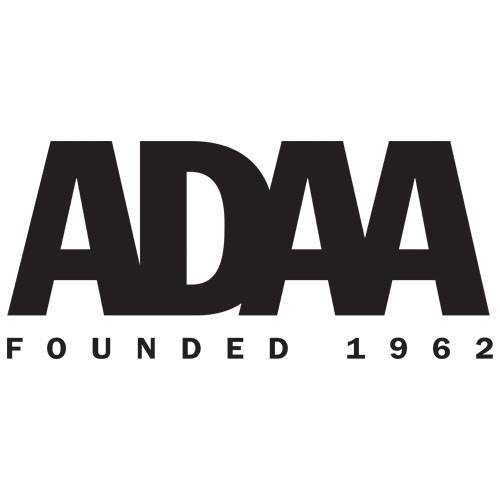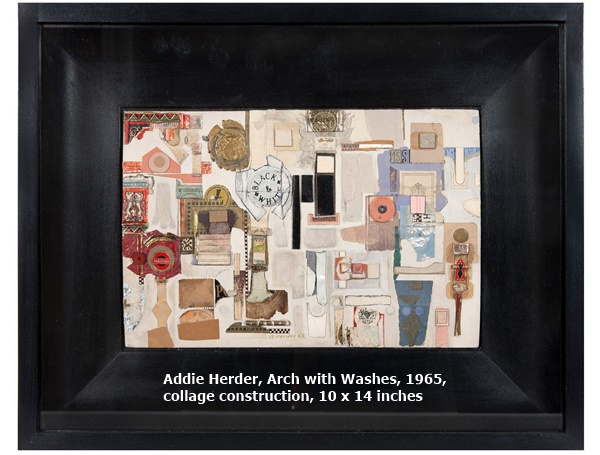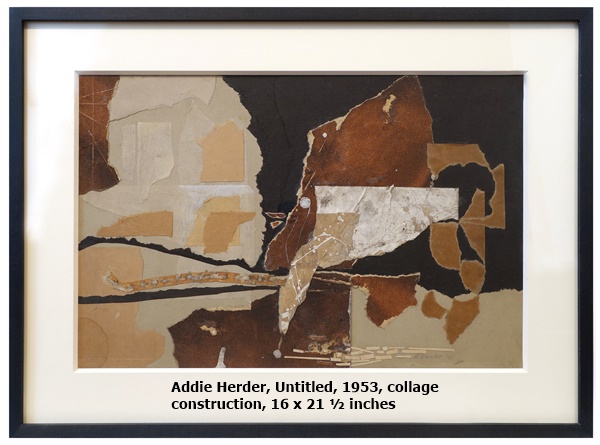Addie Herder

Pavel Zoubok Fine Art
41-54 22nd St, Long Island City, NY 11101, United StatesT 212) 6757490 e-mail:



ADAA 2020
Park Avenue Armory Park Avenue at 67th Street New York Citytelephone: 212 488 5550 fax: 646 688 6809
from May 27, 2020



Pavel Zoubok Fine Art is pleased to be participating in ADAA's Artlogic Online Viewing Room initiative featuring the work of ADDIE HERDER. While many of her contemporaries were filling enormous canvases with the barest of pictorial adornment, she went her own way by creating complex facades and "machines" in spaces often no larger than a postcard. Herder used all manner of ephemera to create miniature architectural structures with a theatrical sense of atmosphere and depth. Reflected in the dark, shadowy interiors of her paper constructions is a mechanistic sensibility the underlies much of her work from the 1950s and 1960s, a period that began in New York City at the Sherwood Studios and continued on the streets of Paris.
Addie Herder (1920-2009) had a multifarious genius for collage. The 39 works in this exhibition — the first in New York devoted to Herder’s work since 1996 — cover more than 30 years. They date from 1954, when Herder and her husband were commercial designers in New York (Jell-O was a client), to 1988, when the marriage and the business were both long gone. By then Herder had lived in Paris for more than a decade (1963-74), and been accorded seven solo shows in galleries in New York and London and a survey at the Neuberger Museum in Purchase, N.Y.
The collages here have an amazing range, notwithstanding their consistent intimacy of scale, clarity of composition and sensitive use (and cutting!) of tremendously varied bits of paper, cardboard and whatnot. To one extreme lie dense, built-out constructions that resemble tiny, rather realistic stage sets. To the other lie flat, relatively abstract works in which well-placed elements grace expanses of bare paper.
In between, many other artistic options are embraced. Along with echoes of Kurt Schwitters and Joseph Cornell, there are hints of Robert Rauschenberg’s “Combines,” Louise Nevelson’s black reliefs and various strains of Abstract Expressionism and Pop Art.
There are also signs of things to come: “Fugue” (1968), with its dense field of cutout floral motifs, presages the layered patterns of the painter Philip Taaffe by some 20 years. In all this, Herder emerges as a rarity: a kind of ventriloquist with a distinctive voice of her own who deserves a place in collage’s elaborate, still unfolding history.
Addie Herder (1920-2009) had a multifarious genius for collage. The 39 works in this exhibition — the first in New York devoted to Herder’s work since 1996 — cover more than 30 years. They date from 1954, when Herder and her husband were commercial designers in New York (Jell-O was a client), to 1988, when the marriage and the business were both long gone. By then Herder had lived in Paris for more than a decade (1963-74), and been accorded seven solo shows in galleries in New York and London and a survey at the Neuberger Museum in Purchase, N.Y.
The collages here have an amazing range, notwithstanding their consistent intimacy of scale, clarity of composition and sensitive use (and cutting!) of tremendously varied bits of paper, cardboard and whatnot. To one extreme lie dense, built-out constructions that resemble tiny, rather realistic stage sets. To the other lie flat, relatively abstract works in which well-placed elements grace expanses of bare paper.
In between, many other artistic options are embraced. Along with echoes of Kurt Schwitters and Joseph Cornell, there are hints of Robert Rauschenberg’s “Combines,” Louise Nevelson’s black reliefs and various strains of Abstract Expressionism and Pop Art.
There are also signs of things to come: “Fugue” (1968), with its dense field of cutout floral motifs, presages the layered patterns of the painter Philip Taaffe by some 20 years. In all this, Herder emerges as a rarity: a kind of ventriloquist with a distinctive voice of her own who deserves a place in collage’s elaborate, still unfolding history.
 |
Addie Herder |








